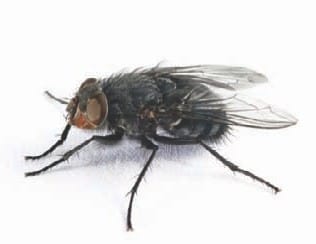Advances in flying insect control improve food safety
The European horse meat scandal dominated food safety headlines in 2013. How the supply chain became contaminated is still a topic for debate and the controversy will no doubt rage on in boardrooms around the world. In the wider context of legislation, the Food Safety Modernisation Act introduced by the FDA in 2011 is impacting the American landscape, whilst in the UK 2013 sees the roll out of the Food Hygiene Rating Scheme. Both of these initiatives further highlight the need to maintain focus on improving standards in the food indus- try and continually improve and enhance defences against all forms of pests.
The global food safety environment in 2013
The supply chain begins at source and, in the case of meat, initial responsibility lies with breeders and commercial farmers. Economic pressures are dictating the use of antibiotics as growth promoters. Recent studies on commercial pig farming opera- tions in Kansas and North Carolina have shown that the digestive tract bacteria in pigs are often exposed to selective pressure and many become resistant to antibiotics. Flies can move freely between animal waste and food and may play a significant role in the dissemination of antibiotic resistant bac- teria within and between animal production farms and residential settings.(ref .1)
In addition, the food industry is not immune to financial pressures, and with the global economic situation still some way from returning to growth, the industry is being put under the strain of minimising costs without impacting safety or perform- ance. This is also manifesting itself through reduction in energy consumption as part of efficiency drives and to align with green marketing initiatives particularly in the retail sector. From a health and safety point of view, the FSA, states that “the cost and burden of UK food borne disease remains unacceptably high. The majority of food borne illness is preventable and there is scope to reduce levels of disease.(ref.2)
These legal, political, economic and social drivers all result in an increasingly difficult environment to manage within the food industry, resulting in a higher reli- ance on pest management professionals to help producers to minimise risk and meet hygiene criteria.
Flying insects in food safety
It has been an established fact for many years that flying insects are carriers of bacteria and viruses that can introduce disease at all points within the food chain. Indeed, a study by researchers in Denmark estimated that as many as 30,000 flies could enter a poultry house over the course of six week period(ref. 3) – the consequences can be lethal.
Researchers at the Johns Hopkins Bloomberg School of Public Health in the United States recently found evidence that houseflies may contribute to the dispersion of drug-resistant bacteria and thus increase the potential for human exposure to drug-resistant bacteria. “Flies are well- known vectors of disease and have been implicated in the spread of various viral and bacterial infections affecting humans, including enteric fever, cholera, salmonellosis, campylobacteriosis and shigellosis,” said lead author Jay Graham, PhD, who conducted the study as a research fellow with Bloomberg School’s Center for a Liveable Future. “Our study found similarities in the antibiotic-resistant bacteria in both the flies and poultry litter we sampled”(ref. 4). The implications of such studies has a wider social impact than the impact a single product recall has on a brand or manufacturer, and indicates how far reach- ing the impact of poor sanitation and flying insect control practices can impact.
Research on the implications of flies within the food chain continues and this increasing knowledge helps to improve working practices in the pest control and food industry.
Food safety management and flying insect control
Hazard Analysis Critical Control Point or HACCP is the systematic preventive approach to food safety that address’s the physical, chemical, and biological hazards as a means of prevention rather than finished product inspection. Originally developed in the 1960s for NASA to take food into space safely, HACCP is now widely used in the food industry to identify potential food safety hazards, so that key actions can be taken to reduce or eliminate the risk of the hazards being realised. Effective hazard identification is seen as so vital as it leads to appropriate control measures later on in the HACCP process.
Within the HACCP process, an effective flying insect control strategy is essential; with one of the key tools used in this being an insect light trap. The insect light trap can be used to undertake effective hazard identification, provide on-going monitoring of critical control points and verify the success of corrective actions – three of the key areas within the HACCP program.
Grant Chaplain, Chief Marketing Director of market leading manufacturer Brandenburg, comments: “the traditional thinking of an insect light trap only being used to catch flies misses the key point. Flies are there for a reason and, by analys- ing the contents of the glue board, species type can be determined as well as volume. From this information, it will be possible to identify the source of the infestation and take remedial action to reduce the likeli- hood of recurrence.”
Effective flying insect control and corrective action – performance efficacy is critical
Researchers have discovered that fly behaviour is both complex and unpredictable and is influenced by a variety of factors including temperature, humidity, ambient light levels, time of day, level of ultra-violet light, the sex and age of the fly. So, in order to obtain a meaningful assessment of the performance of a given fly trap design, it is necessary to carry out testing under tightly controlled conditions which may be replicated in other laboratories. At Brandenburg, the research and development protocol demands that multiple independent tests are conducted around the world, using both laboratory and wild strains of a given fly species. Due to the large variations in fly responses to a given set of stimuli, it is also essential to repeat the trials several times to make a valid statistical analysis of the results possible.
Following the release of the Genus® range of insect light traps in 2011 and its subsequent expansion with a raft of new models, Brandenburg undertook a series of product tests to analyse the performance of their ILTs to benchmark efficacy in relation to competitors in terms of rate of catch.
Results proved extremely positive, with an average catch rate of 86% of house flies across the Brandenburg units tested compared to 67% for similarly powered competitor units after 180 minutes. Three products within the range – Genus® Fli, Orbit, and Optica demonstrated outstanding efficacy in the initial stages of the tests, catching 30% of flies after 30 minutes, compared to 14% for the competitor units.
Fast catch rate essential for increasing hygiene and minimizing risk
Having established the importance of a fly trap as an important tool within food safety, the next challenge is to ensure the correct specification of model and placement within the facility is chosen. The presence of a fly trap in an enclosed space would eliminate all flies eventually, however industry expert Dr. Stephen Howe, comments that “in sensitive environments such as the food industry, the effectiveness of a trap should be demonstrated by the rate at which flies are eliminated, not that they are simply eliminated eventually.”
 To facilitate fast catch rates, Brandenburg has created Translucent Technology™ (TT™), a unique UV propagation system that increases the distribution of the UVA dispersed from an insect light trap. Genus® Orbit incorporates TT™ which produces 2.4 times more UVA than a non TT™ unit of a similar power. Conventional insect light traps disperse UVA from only the front (and some from the sides) of the unit creating a limited attraction window. Genus® Orbit disperses UVA from the top, front and sides of the unit giving an all round attraction window.
To facilitate fast catch rates, Brandenburg has created Translucent Technology™ (TT™), a unique UV propagation system that increases the distribution of the UVA dispersed from an insect light trap. Genus® Orbit incorporates TT™ which produces 2.4 times more UVA than a non TT™ unit of a similar power. Conventional insect light traps disperse UVA from only the front (and some from the sides) of the unit creating a limited attraction window. Genus® Orbit disperses UVA from the top, front and sides of the unit giving an all round attraction window.
Independent tests have shown Genus® Orbit catches 186% more flies during the first 30 minutes compared to non TT™ units of similar power. Furthermore Genus® Orbit also caught 27% more flies than a 75W non translucent unit. This faster reduction of flying insects from sensitive food environments reduces the risk of food borne pathogens carried by flying insects, helping to increase overall food safety and also reducing energy costs and CO2 emissions as fewer ILTs are required to generate the same results.
As well as being vectored by flies, many disease pathogens can also be seen to be airborne. Bacteria and viruses that are present in the air, pose a threat of infection. Many “lighter than air” bacteria and viruses can be carried around sensitive environments on the smallest of dust particles. These organisms are easily transferred by natural, everyday air currents before settling on their hosts or surfaces and equipment, from where they can enter the food chain.
In addition to implementing an effective flying insect control program, the food industry can now benefit from removing airborne pathogens from key environments to greatly improve environmental hygiene and significantly reduce the opportunity for airborne vectored disease to enter the food chain. A new innovative tool in this battle has recently been developed by Brandenburg. Genus® Orbit Innova successfully integrates proven UVC air sterilisation technology within the ILT.
As air moves through Genus® Orbit Innova – via convection from the UVA bulbs – it is directed to pass through a small compartment at the top of the product containing a powerful UVC bulb. UVC has a shorter wavelength than UVA and has sterilising properties. As air passes over the bulb, airborne pathogens are reduced by up to 95% for fungal emissions and 65% for bacterial. The benefits for the food industry and other sensitive environments are great – giving additional options for improving safety and protection.
Looking to the future
Scientific research is continuing to improve knowledge and understanding of entomology and insect behaviour whilst product innovation is driving improvements in catch rate and cost savings for end users. This double-ended approach will continue to bring benefits at all stages of the supply chain, resulting in standards of food hygiene improving independently of the drive from legislation.
ref. 1 – http://www.k-state.edu/media/webzine/bioscience/houseflies.html
ref. 2 – http://www.food.gov.uk/safereating/microbiology/fds/
ref. 3 – http://www.scientistlive.com/European-Food-Scientist/Food_Safety/Flies_may_spread_drug-resistant_bacteria/21908/
ref. 4 – http://www.scientistlive.com/European-Food-Scientist/Food_Safety/Flies_may_spread_drug-resistant_bacteria/21908/
Author: Tahir Rashid at +44 (0) 1 384 472 900 or e- mail marketing@b-one.com
Brandenburg UK Ltd.
Published in International Pest Control – July/August 2013 issue.
Category: Public health, Special features












